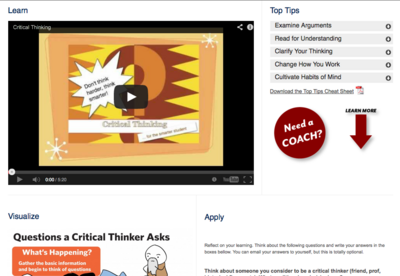Documentation:Learning Design Process Example 2
Just Do It! Confessions from a Student-Led Project

This is our documentation of our learning experiences as a student/staff design team involved in the creation of Student Toolkits on the Learning Commons site. Each phase highlights video interviews with the team - sharing their observations.
The working team
- Sharon Doucet: developed content supported the process and supported focus groups.
- Nick Thornton: developed content and infographics and supported focus groups.
- Nick Harvey-Cheetham: revised content, re-designed pages for second iteration and supported focus groups.
- Sam Wempe: developed content and forms/ reflection activities.
- Gillian Corbo: developed content and video and supported focus groups.
- Cindy Underhill, Learning Resource Design Strategist - CTLT - role: to provide framework for the design of the toolkits and facilitate working meetings to explore challenges and discuss approaches to the design. Facilitated and provided guidance on set up of student focus groups to assess usability of toolkits.
- Highlight extra-curricular student-led projects as learning opportunities that can be as powerful as the best learning experiences in the classroom.
- Continue to evolve our practices as we share experiences, integrate feedback from users and flesh out questions from colleagues.
- Explore some of the unique qualities shared by true student-led projects and the shift in roles required of collaborators on a student-staff team. Some of those unique qualities?
- passion plus agency. These are initiatives designed by the students - they initiate, develop, revise and take responsibility for outcomes - so students bring a level of passion and interest to the work that is exceptionally high.
- mentorship. Students are learning and benefit with mentorship in areas that are foundational to the project's success. This requires time and dedication to the process.
- risk taking. Learning is messy and projects led by students are as much about their learning as the project outcomes. Sometimes outcomes are unintended.
Purpose+agency+openness+mentorship = sustained motivation +reflection = learning
What Do We Want From You?
- engagement in an honest discussion about the possibilities and pitfalls that you see in each phase of the project. We'll ask: "If you were a mentor to students in this phase of the project, what do you think would be important?" How would you engage with the process?
- reflection on the student confessions/comments related to each project phase. We'll ask: "What stood out about what they shared?" "What observations do you have?"
Context
general: part of the website re-design. tour of a toolkit (Sharon)
Methods
- Open brainstorm: what helps you learn from a self guided resource?
- Weekly working sessions to address learning design issues
- Integration with learningcommons.ubc.ca (using WordPress as platform)
- Adapting existing content for each of the toolkit themes.
- Finding and selecting related resources on each theme to facilitate further exploration.
Resources
| People | Skills | Time | Technology |
|---|---|---|---|
|
|
|
|
Design & Planning Resources
4 Phases
Phase 1: Momentum
| Students are discussing... | Students are engaged in... | Key Themes |
|---|---|---|
|
|
|
Phase 2: Design
| Students are discussing... | Students are engaged in... | Key Themes |
|---|---|---|
|
|
|
Phase 3: Assemblage
| Students are discussing... | Students are engaged in... | Key Themes |
|---|---|---|
|
|
|
Phase 4: Feedback
| Students are discussing... | Students are engaged in... | Key Themes |
|---|---|---|
|
|
|
What is Learning Design?
Basically, it's the design of a learning experience to address an expressed or defined problem or challenge and usually some pre-determined learning objectives or intentions. It involves consideration of the actions that learners may take in order to learn and design decisions are based on current knowledge about how people learn. Like all design processes, it is not linear, it is messy and involves trying things out, seeing what works, making alterations, and re-working. A key component is feedback and dialogue at every step in the process. Coming up with ways to represent the design ideas (or skeleton frameworks for discussion) are essential to the conversation. A good learning design is flexible, re-usable and adaptable to a variety of learning preferences.